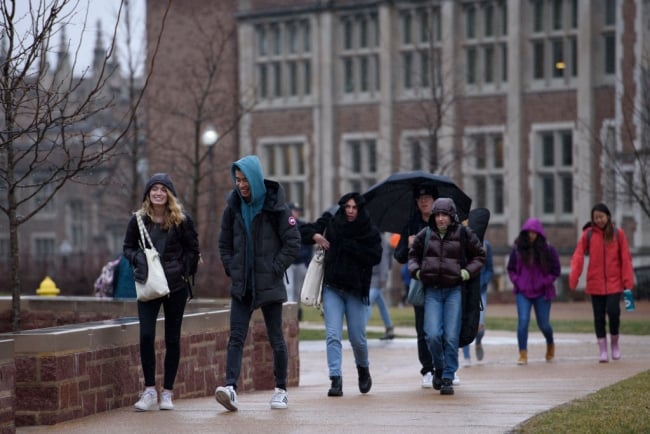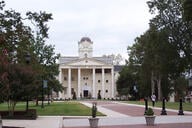You have /5 articles left.
Sign up for a free account or log in.

Washington University in St. Louis saw a 65 percent return on its endowment in fiscal 2021.
The Washington Post/Contributor/Getty Images
America’s wealthiest colleges and universities saw their endowment returns take off in fiscal year 2021 after dismal average returns the year prior.
Bowdoin College reported a 57.4 percent return during fiscal 2021, which ended June 30. Its endowment is now valued at $2.72 billion. The University of Minnesota notched a 49.2 percent return last fiscal year, and Brown University’s endowment gained more than 50 percent, The Wall Street Journal reported. The combined endowment for the University of Illinois System and the University of Illinois Foundation, the system’s fundraising nonprofit, is now valued at $3.82 billion after a 34 percent return in fiscal 2021.
The driving force behind this spike in returns? Alternative investments, said Christopher Good, director of RBC Capital Markets, who works with higher education institutions.
Venture capital, one type of alternative investment, had a banner year in fiscal 2021, according to the Journal. The average valuation of early-stage U.S. start-ups -- which are typically funded by venture capital -- increased by more than 50 percent during the first half of 2021, rising to $96 million.
As a result, the wealthiest colleges and universities got a boost. Endowments valued at more than $1 billion, of which there are relatively few, are more likely to invest in alternative asset classes like venture capital and private equity, recent data from the National Association of College and University Business Officers showed.
“Where you’re going to see higher performance are the institutions with endowments over a billion,” Good said. “If you look at the distribution of where they’re invested, they have a lot more in alternative investments -- in private equity, venture capital. And those asset classes did really well. Those classes outperformed the equity market.” (This paragraph has been updated to clarify the quote.)
Duke University, which sits on a $12.7 billion endowment, saw a 56 percent return in fiscal 2021. Washington University of St. Louis saw even steeper returns, notching 65 percent and growing its endowment to $15.3 billion. The University of California system, which holds $168 billion in investments, saw a 29 percent jump in fiscal 2021 -- the largest one-year gain in the system’s history.
Endowments without significant investments in private equity or venture capital still did well in fiscal 2021. As the world emerged from the pandemic and the country began to reopen, the stock market performed well, said Jessica Wood, a credit analyst at the ratings agency S&P Global.
“When the stock market does well, so do university endowments,” Wood wrote in an email. “Since fiscal 2021 spanned fall 2020 and spring 2021, we saw economies opening up and rebounding.”
Most endowments worth $500 million or less invested a large share of their money in domestic stocks and bonds in fiscal 2020, NACUBO data showed. This is partially because alternative investments have a high start-up threshold that most institutions can’t meet, according to Good.
“You have to have a pretty big endowment to be able to invest in that type of asset class,” he said. “If you have a $50 million endowment, you just don’t have enough cash to be able to buy into those investments, which is why you won’t see big gains from alternatives in those smaller institutions.”
Early numbers in August showed that during fiscal 2021, colleges and universities saw the highest returns since 1986, with a median return of 27 percent. By comparison, institutions saw a 2.6 percent median return in fiscal 2020 and a 6 percent median return in fiscal 2019.
Colleges and universities coupled the good news with information about how they typically spend their investment income. Duke, for example, said it uses investment revenue for student financial assistance, faculty salaries, facilities and research. Bowdoin spends its investment revenue on financial aid, professorships, instruction, museums, its library and technology.
“While the return this past year was simply extraordinary, even more impressive is the long-term record of exceptional performance by our investment team and Investment Committee,” Clayton Rose, president of Bowdoin, said in a statement. “I cannot emphasize enough how important this success will be for the generations of students and scholars who follow us and who will benefit far into the future.”
Most institutions spend a set percentage each year from their endowment earnings. While it’s unlikely that an institution would increase that rate after one good year, the total revenue increases along with the size of the endowment, Good said.
“This will definitely help over the course of the next four years. I think you would expect to see the amount of investment income colleges and universities have to go up,” Good said. “But most colleges would not approach this as, ‘Well, next year, we’re going to triple the amount of investment income that we spend.’ That would be very unusual.”
Most colleges didn’t see a 50 or 60 percent return in fiscal 2021. Hundreds of colleges don’t have endowments at all, and even those that do typically do not invest in the alternative asset classes that are likely behind the boom for Duke and Washington University.
“When people hear about Duke having a huge outside gain in endowment, the whole sector tends to get characterized by how the people that are the highest performing are doing,” Good said.
For the colleges that did see big returns last fiscal year, how long will the good news last?
“I don’t have a crystal ball, but looking back on several years of precedent endowment returns, another year with these types of major returns is unlikely,” Wood said. “Most economists are projecting more subdued returns this year given the Delta variant and related uncertainties.”




